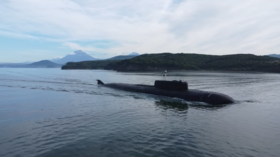US unveils new Arctic strategy

The administration of US President Joe Biden released its ten-year National Strategy for the Arctic on Friday, which has a heavy focus on the challenges Russia supposedly poses to American influence in the region.
The policy document, which had not been updated since 2013, outlines “four mutually reinforcing pillars” meant to guarantee that the region remains “peaceful, stable, prosperous, and cooperative.” The US intends to achieve this by deterring threats, building resilience to climate change, enabling sustainable economic development, and engaging with its partners and allies.
Meanwhile, the strategy also claims that “Russia’s aggression in Ukraine” has complicated cooperation in the Arctic in general, adding that under the current circumstances regional engagement with Moscow has become “virtually impossible.”
Staying on the subject of Russia, a major regional player, the document says that Moscow “has invested significantly” in its military presence in the Arctic by modernizing its military bases, deploying new defense systems and submarines, as well as ramping up military exercises in the area.
It also states that Russia is developing new economic infrastructure in the region to extract its abundant resources while accusing Moscow of “attempting to constrain freedom of navigation” along the Northern Sea Route.
In light of this, the US intends to maintain and advance its military presence in the Arctic “in support of our homeland defense, global military and power projection, and deterrence goals.” In particular, this will be underpinned by an expansion of the US Coast Guard icebreaker fleet. The US currently operates only two ships of this type, while Russia has over 40.
Meanwhile, while the US plans to enhance its military capabilities in the region, it also seeks to “manage risks of further militarization or unintended conflict,” including those resulting from geopolitical tensions with Russia.
The document goes on to say that China “seeks to increase its influence” in the Arctic by pursuing economic, diplomatic, scientific, and military activities, adding that Beijing has doubled its investments in the region, with a heavy focus on extracting minerals.
The Biden administration released the document after NATO Secretary General Jens Stoltenberg promised in late August that the US-led bloc would increase its military presence in the Arctic, arguing that Moscow and Beijing pose a “strategic challenge” to the alliance. He also stated that a “rapidly warming climate” and melting ice sheet would unlock economic opportunities that can be exploited by “authoritarian regimes” such as Russia and China.
Following Stoltenberg’s statement, Kremlin Press Secretary Dmitry Peskov said that Moscow’s cooperation with other countries in the Arctic poses no threat to anyone and is meant only to promote economic development. Meanwhile, Chinese Foreign Ministry spokesman Zhao Lijian slammed NATO for still dwelling in the Cold War.













